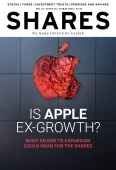Archived article
Please note that tax, investment, pension and ISA rules can change and the information and any views contained in this article may now be inaccurate.
Is Apple ex-growth? What it means if the days of rapid expansion are over

Is it now time to start thinking the unthinkable – that while undoubtedly still an exceptional company, Apple (AAPL:NASDAQ) is no longer an exceptional stock?
For example, most investors would probably view British American Tobacco (BAT) or Nike (NKE:NYSE) as high quality companies, yet their respective total returns (share price plus dividends) performances annualised over the past decade are dismal, both at 3.4%. A FTSE 100 tracker would have nearly doubled that, at 6.1%, while the S&P 500’s 12.8% is roughly three-and-a-half times that.
Apple has been a very different story. It goes down as one of the great investments in a generation. Over the past 20 years, the stock has produced total returns of 17,700%. That’s a difficult number to get your head around, so let’s put it another way… the share price has surged from $1.45 to the current $212.33, adjusted for stock splits.
British American Tobacco and Nike, incidentally, have put up 484% and 685% respectively over two decades.
Yet, as the world turns, what worked in the past might not work so in the future, and the world has, metaphorically speaking, never turned as quickly as now, and the rotation is getting faster.
Which brings us back to Apple. The stock currently trades on a rolling 12-month PE (price to earnings) multiple of 28.2, according to Stockopedia data, a 34% premium to the S&P 500’s 18.4 12-month PE.
We all know that stock markets tend to reward companies it believes have strong future growth potential with premium valuations. The question is, can Apple’s future growth justify investors’ high expectations? The raw data suggests it may be time to think of Apple as something other than a growth stock.
HAS IPHONE HAD ITS DAY?
Apple is known for innovation, brand power, high margins, and a large cash reserve. All of these observations are valid. The iPhone, launched in 2007, has been Apple’s moat, and the ecosystem that has captured billions of users, many of them loyal. The business model relies on premium pricing, exceptional user experience, and an integrated ecosystem that increases switching costs.
Apple is already the number one handset manufacturer in the world, with an estimated 27.4% market share. Only Samsung comes close (22.9%), the rest trail miles behind. Apple stopped publishing handset numbers years ago, but hardware revenues have been slowing in recent years. iPad revenues peaked in 2021, Mac and iPhone the following year, all three device lines have been flat or in decline since.
This means device revenues as a percentage of total income have fallen sharply since peaking at around 63% in 2018 to 51.5% in 2024 (to end September).
Apple has for years been desperately trying to think up that killer next device to full the iPhone growth gap – car, VR headset, watches – some real, some mere speculation, but it has failed.
The real growth driver in recent years has been the Services business – the App Store, Apple Music, Apple TV etc. This revenue line has nearly doubled since 2017 and last year was worth about a quarter of the firm’s $391 billion revenue.
Services revenues hit $26.6 billion in Q2 2025, up about 12%, making them worth a fraction off 28% of Apple’s near $95.4 billion total.
Apple’s March-quarter revenue rose 5% year-on-year, with iPhone revenue rising 2% to $46.8 billion. Gross margin rose 50 basis points year-on-year to 47.1%. ‘Results and revenue guidance were positive to us,’ wrote Morningstar analysts, but margin guidance was weak, resulting from an estimated $900 million impact from US tariffs. ‘Primarily, we see material risk for Apple from tariffs, both on profitability and longer-term demand.’
Where those tariffs end up matters enormously to Apple and its shareholders. Apple’s core devices are currently exempt from US tariffs, and the June quarter impact is primarily from accessories. Nonetheless, Apple remains at risk of a policy change by the capricious Trump government.
Positively, most US iPhone units are imported from India, which faces a lower current tariff rate than China (10% vs 145%), and Apple continues to shift device manufacturing from China to India, a process that started a few years ago but may have been accelerated thanks to the Trump administration.
Even so, the current lack of any sort of certainty over US economic policy right now represents a huge risk to Apple. Morningstar estimates a 25% gross downside risk to earnings and Apple’s intrinsic valuation if it were to lose its exemption and face the full brunt of tariffs, and although Apple could mitigate some of the potential damage by upping prices, that would surely tighten the screw on consumers, for some, to breaking point, impacting volumes.
There are other risks to consider too, such as its $20 billion a year search deal with Google. Right now, Apple just keeps Google as the default and watches as the money rolls in. Google runs that search business and does as efficiently as only a behemoth can.
If the deal goes south, Apple loses $20 billion a year for which it does virtually nothing. It would also have to replace or at least supplant Google search, which is where the talk of using AI tools, such as Perplexity comes in, although Morgan Stanley suggests that Apple would not be able to monetise AI-based search remotely well enough to get it the revenues it currently has. Watch this space.
Elsewhere, regulators will eventually force Apple to compete with other services on its own platforms. If things like its Siri ‘assistant’ remain relatively comparable with alternatives, many Apple users will continue to use them.
One factor that could support Apple’s premium valuation would be a successful pivot to AI (artificial intelligence) as a growth driver. The company has been rolling out its Apple Intelligence features, which it hopes will drive iPhone upgrades and strengthen its ecosystem advantage.
But there’s no guarantee this thesis will play out, and things haven’t been going smoothly. Apple’s cautious approach to its AI rollout could cause demand for the latest iPhone models to be lower than expected. Some features were initially available only in certain markets and languages, and other key features have reportedly been delayed, such as its souped-up Siri, apparently until 2026.
HIGH VALUATION, LOW RETURNS?
To justify a near 30 PE, investors typically expect one of two things:
- Rapid and sustainable growth, or
- Strong yields — via dividends, buybacks and cash flows.
According to analysts at Trefis, Apple offers neither. You might start to see their point when you look at revenue growth over the last three years, which has contracted by more than $3 billion, and over the past 10 quarters, has averaged 0.8%. Earnings growth has averaged a little over 6% a year.
Looking ahead, the picture doesn’t get any better. According to Koyfin consensus, revenue and earnings are expected to grow an average 5.6% and 10% out to 2027.
‘That’s not a growth stock, it’s a mature business sporting a growth multiple,’ argues Trefis. Albeit these are likely to be very reliable revenues and profits.
What about dividends and buybacks? Apple paid shareholders $15.2 billion in ordinary dividends last year, and nearly $88 billion over the past five fiscal years. But don’t get too excited, that averages annual growth of 5.4%, below the average growth of earnings or free cash flow per share.
The payout ratio (how much of earnings are paid in dividends) over the past five years averages 16%, versus 35% of the S&P 500. Based on current data, the dividend yield is a paltry 0.5%, or thereabouts.
Share buybacks have dwarfed dividends, totalling $475 billion over the past five years. While buybacks have long been seen as an efficient way to return value to shareholders by propping up earnings, a snag has emerged since the Inflation Reduction Act (IRA) was signed into law in August 2022.
Among other things, it imposes a 1% excise tax on share repurchases in a tax year that are made by certain publicly traded corporations, including Apple, and makes buybacks a far less cost-effective way of returning value. Major Apple investor Warren Buffett, via Berkshire Hathaway (BRK.B:NYSE), complained that last year’s buybacks meant Apple handed the US government a tidy sum for nothing, when it could have significantly upped shareholder dividends and avoided the tax charge.
IN CONCLUSION
Returning to Apple’s 17,700% total return over 20 years we mentioned at the start of this feature. That ranks Apple as the fourth best total return performance among current S&P 500 members, behind just Nvidia (NVDA:NASDAQ), Netflix (NFLX:NASDAQ) and Booking Holdings (BKNG:NASDAQ). Run the same data over 10 years, and Apple’s 584% ranks it 47th, or 134th over the past five years (182%), although it’s unclear if this is a leading indicator.
For example, annualised 10- and five-year total returns remain well above S&P 500 and Nasdaq Composite averages at 21% and 23%.
Even so, as Blue Whale Growth’s (BD6PG78) Stephen Yiu says: ‘What works today may not work tomorrow. Passive ownership of stocks may deliver comfort, but it won’t deliver outperformance.’
Let’s be clear, Apple remains an excellent business, but there are more questions now about how good an investment it is than in years. Given its market cap of $3.17 trillion, and grip on US and global indices, exposure to Apple is almost inescapable.
But it may be time for investors to reassess their view of what kind of investment Apple is, and what kind of future returns it is likely to generate.
The author of this article (Steven Frazer) owns a personal stake in Blue Whale Growth.
Important information:
These articles are provided by Shares magazine which is published by AJ Bell Media, a part of AJ Bell. Shares is not written by AJ Bell.
Shares is provided for your general information and use and is not a personal recommendation to invest. It is not intended to be relied upon by you in making or not making any investment decisions. The investments referred to in these articles will not be suitable for all investors. If in doubt please seek appropriate independent financial advice.
Investors acting on the information in these articles do so at their own risk and AJ Bell Media and its staff do not accept liability for losses suffered by investors as a result of their investment decisions.
Issue contents
Ask Rachel
Editor's View
Feature
Great Ideas
News
- It’s business as usual for contractor Costain as shares hit five-year high
- Victorian Plumbing shares hit new low as group plans MFI comeback
- What tender offer means for Polar Capital Global Financials Trust investors
- Moody's cuts US credit rating
- These are the stocks ‘guru’ investors have been buying and selling this year
- Buy into chemicals company Victrex at an attractive valuation
 magazine
magazine








